七年级英语上册《Module 9 People and places Unit 3 Language in use》教案 外研版
- 格式:doc
- 大小:106.50 KB
- 文档页数:6
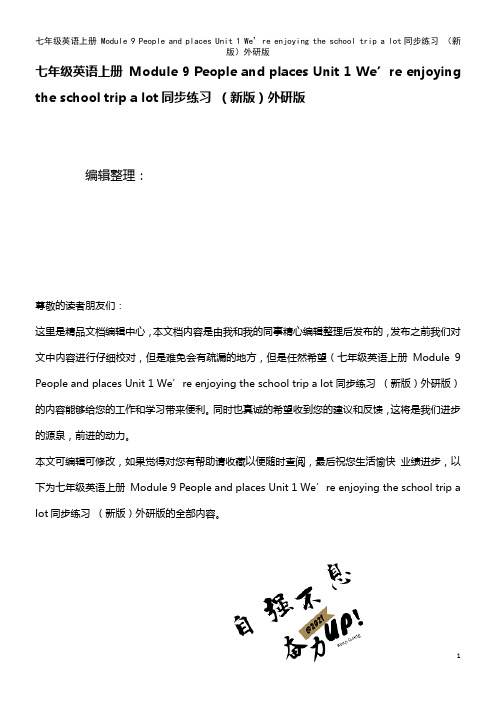
七年级英语上册Module 9 People and places Unit 1 We’re enjoying the school trip a lot同步练习(新版)外研版编辑整理:尊敬的读者朋友们:这里是精品文档编辑中心,本文档内容是由我和我的同事精心编辑整理后发布的,发布之前我们对文中内容进行仔细校对,但是难免会有疏漏的地方,但是任然希望(七年级英语上册Module 9 People and places Unit 1 We’re enjoying the school trip a lot同步练习(新版)外研版)的内容能够给您的工作和学习带来便利。
同时也真诚的希望收到您的建议和反馈,这将是我们进步的源泉,前进的动力。
本文可编辑可修改,如果觉得对您有帮助请收藏以便随时查阅,最后祝您生活愉快业绩进步,以下为七年级英语上册Module 9 People and places Unit 1 We’re enjoying the school trip a lot同步练习(新版)外研版的全部内容。
Module 9 People and places Unit 1Ⅰ.根据句意及首字母提示补全单词。
1.He is d______ in his friend's car.2.I'm very busy.I have lots of t______ to do.3.My sister is t______ a photo of my cat。
4.I won't let you wait for me for long。
I will be b______ soon(不久).5.In the classroom,the students are studying their l______。
Ⅱ.根据汉语提示完成句子。
1.I have to __________ (待在家里) and do my homework.2.The baby __________ (不是在睡觉) in the bedroom。

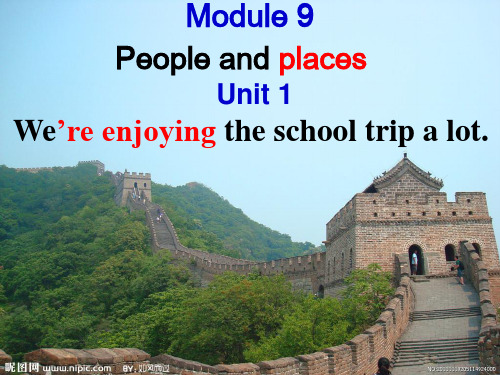
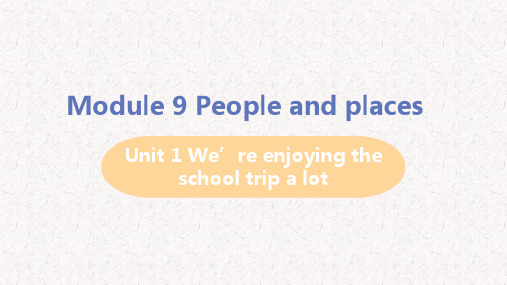
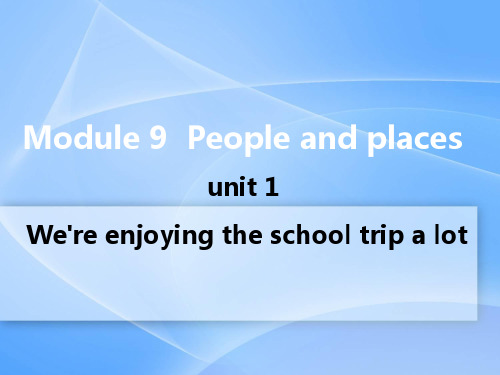
We're enjoying the school trip a lot明信片驾驶、开车离开尽管如此饭店、餐厅仍然享受...的乐趣、喜爱postcard drive leaveanyway stillenjoy restaurant行、排、列大部分时刻、时候卖、销售事情、东西旅行sale thingtrip linemostmoment1.we’re on a school trip . 我们在学校旅行。
on a school trip 意为“在进行学校旅行”,on表示“正在进行”。
关于“trip”的短语还有:the trip to ......去....旅行;on the trip意为“在郊游、在旅行”,go on a trip意为“去旅行”。
She is on the trip to Shenzhen .辨析:trip与travel①trip 作名词,一般用来指距离较短的旅行或旅游。
How is your weekend trip?②travel 泛指“旅行”,既可作名词,又可作动词。
一般指长时间、远距离的旅行;作名词时,前面一般不加冠词。
They often travel to big cities .2.What about the others ? 其他人怎么样?the others 意为“别的(人/物),其他的(人/物)”。
表示一定范围内除去一部分以后的其余部分,相当于“the other +名词复数”,在前面加the 表示特指。
There are fifty students in our class . Twenty of them like playing basketball ,and the others like running .我们班里有50人。
其中20人喜欢打篮球,其他人喜欢跑步。
3. a few 意为“一些、几个”There are a few pictures on the wall .墙上有几幅照片。
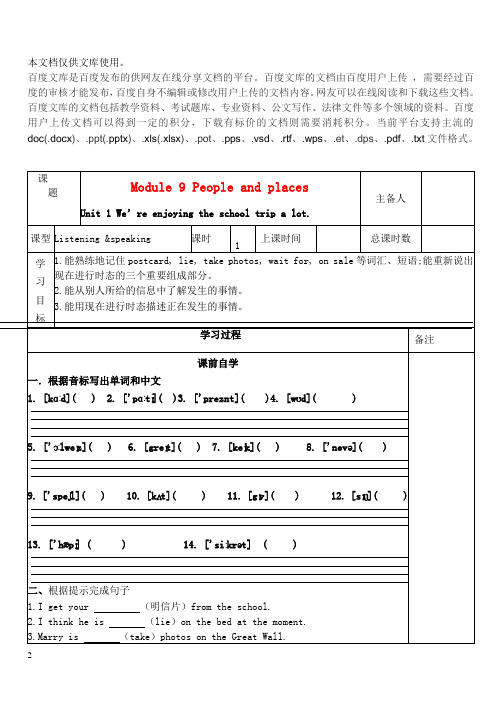
本文档仅供文库使用。
百度文库是百度发布的供网友在线分享文档的平台。
百度文库的文档由百度用户上传,需要经过百度的审核才能发布,百度自身不编辑或修改用户上传的文档内容。
网友可以在线阅读和下载这些文档。
百度文库的文档包括教学资料、考试题库、专业资料、公文写作、法律文件等多个领域的资料。
百度用户上传文档可以得到一定的积分,下载有标价的文档则需要消耗积分。
当前平台支持主流的doc(.docx)、.ppt(.pptx)、.xls(.xlsx)、.pot、.pps、.vsd、.rtf、.wps、.et、.dps、.pdf、.txt文件格式。
Module 9 People and placesUnit 1 We're enjoying the school trip a lot.Step 1Warming up1.Show some pictures of the Great Wall and have a dialogue students. (详见素材一导入二) Step 2Prelistening1.Read through the words and expressions in the box in Activity 1 and let the students repeat them. Make sure they understand them.buy postcards, call, lie in the sun, shop, stand in line, take photos, wait for the bus, walk on the Great Wall2.The students read the words and expressions together.3.The students look at the pictures and talk about them.Step 3Listening1.Ask the students to look at the pictures in Activity 1 again.2.Play the recording of Activity 2 once while the students just listen.3.Play the record again, then they can number the pictures.4.Check the answers with the whole class.Step 4Listening and reading1.Ask the students to listen to the dialogue and finish the exercises.(详见素材三)2.Read the dialogue for five minutes and complete the table in Activity 3.3.Listen again and check the answers with a partner, then check the answers with the whole class.4.Let the students close the text book, and practise the dialogue with their partners according to the table in Activity 3.5.Choose two groups to act out the dialogue.Step 5Practice1.Ask the students to read through the passage in Activity 4.2.Underline the correct words.3.Check the answers with all the students.[答案] (1)trip (2)a few (3)sale (4)are enjoyingStep 6Listening and repeating1.Play the recording of Activity 6 once without stopping.2.Ask the whole class to repeat after it.3.Ask the students to practise the sounds in pairs.Step 8Working in pairsHave the studetns say what the people are doing at the moment.I'm learning English. My teacher is talking. My classmates are listening to theteacher carefully. Oh, no, Tony and John are making faces to each other. My teacher is looking at them seriously…Step 9Language points (详解见学案部分)1.lie v. 躺;躺2.Anyway, it's time to go back to school now.无论如何,现在到返校的时间了。
Module 9 People and placesUnit 3 Language in use一、学习目标:1. 重点单词:postcard, call, lie, sun, line, take, wait, wal k, trip, few, sales, enjoy, anyway, back, drive, off, hot dog, leave, restaurant, moment, place, things, most, still, star, run, study2. 重点短语:3.重点句子:1) We’re enjoying the school trip a lot.2) I’m standing on the Great Wall of China and talking to you.3) Tony is eating a delicious ice cream.4) Wang Hui is taking lots of photos.5) Lingling is buying a few presents and postcards.6) They’re waiting for buses or trains.7) At this moment, in different places of the world people are doing different things.8) They’re working.9) People aren’t having dinner.10) Some people are still working and some are going home from work.11) They are eating hamburgers or hot dogs and drinking coffee or cola.12) Some people are seeing friends, calling home or shopping.二、重点及难点:1. Function: How to describe and ask what the people are doing at the moment.2. Grammar: The Present Continuous Tense.三、教学设计:Unit 3 Language in useⅠTeaching modelRevision and applicationⅡTeaching methodFormal and interactive practiceⅢTeaching aims1. To encourage students to share and express what they are doing using what they have learned in this module.2. To learn how to write a postcard.ⅣTeaching Objectives1. Function: How to describe and ask what the people are doing at the moment.2. Grammar: The Present Continuous Tense.ⅤTeaching aidsTape recorder, OHP, han doutsⅥTeaching StepsStep 1 RevisionReview the text of Unit 1 and Unit 2.Step 2 Language practice1. Read through the example sentences in the box with the whole class.2. Ask the students to repeat the sentences in the box.3. Grammar: The Present Continuous Tense.现在进行时 (1)1. 定义:表示现在正在进行的动作。
2. 构成:be + 动词的现在分词。
Be (am is are) 随着人称、数的变化而变化。
1) 动词后面直接加ing: do → doing buy → buying2) 以e结尾的动词去e加ing : have → having take → taking3) 以重读闭音节结尾的单词,双写最后一个字母,然后加ing:run→ running swim → swimming4) 特殊形式的变化:lie → lying4. 现在进行时的否定句结构:sb. + be not + doinge.g. I’m not visiting my friends now.He isn’t writing a postcard.5. 现在进行时的一般疑问句结构:be + sb. + doing + 其他?e.g. Is she enjoying her visit?Are they b uying postcards?6. 常与现在进行时态连用的词:now, listen, look 等。
e.g.1. I’m reading now. 我现在正在读书。
2. Listen! She is singing.听, 她正在唱歌。
3. Look! My parents are watering the flowers. 看, 我的父母亲正在浇花。
Step 3 Work in pairs1. Look at the picture.2. Ask and answer: What can you see? What are they doing?3. Ask the students to talk about the picture.4. Read through the example sentences with the whole class.Tony is calling a friend.Step 4 Complete the conversation in Activity 2.1. Read through the conversation with the whole class.2. Ask the students to complete the conversation between Tony and his dad with the correct form of the words in brackets with a partner.3. Call back the answers from the whole class, check the answers.Keys: 1. are visiting 2. are writing 3. is taking 4. are enjoying 5. are looking 6. are looking 7. are having4. Read the conversation together.Step 5 Write about the pictures in Activity 3.1. Read through the sentences with the whole class.2. Look at the pictures in Activity3.3. Ask the students. What can you see?4. Read through the example sentences.Some boys are playing football.They aren’t playing basketball.5. Ask the students to write about the pictures with a partner.6. Call back the answers from the whole class, check the answers.Keys: 1. are playing, aren’t playi ng 2. isn’t watching; is workingStep 6 Work in pairs1. Read through the expressions in Activity 4 with the whole class.driving a car getting upgoing to sleep lying in the sunplaying basketball running for a busstudying history taking photoswatching TV writing postcards2. Mime an action for your partner to guess.3. Read through the example conversation with the whole class.A: You’re running for a bus!B: No!A: You’re playing basketball!B: Yes!4. Use the expressions to help you.5. Work in pairs.6. Learning to learnWhen you revise your vocabulary, choose words which are useful for you, and write them in sentences.postcard: On holiday I usually send four or five postcards to my friends.Step 7 Around the world:1. Ask the students to look at the pictures and discuss what they can see.It’s morning in New York.It’s midday in London.It’s evening in Sydney.2. Read through the information with the whole class, and talk something about them.3. Ask and answer.4. Read the passa ge together.Step 8 Module task: Making a radio report.1. Work in groups of three or four. Plan a radio report.2. Talk about news you would like to report.3. List the activities you would like to report.Make notes about the news.Write what you are going to say.4. Work in pairs.5. Show your report to the whole class.6. Choose the best report.Step 9 Do exercises.I. 用单词的正确形式填空。